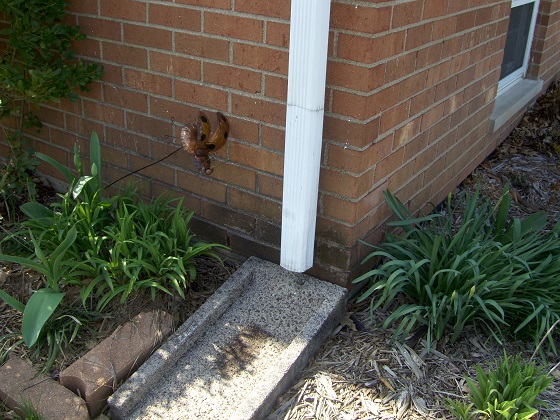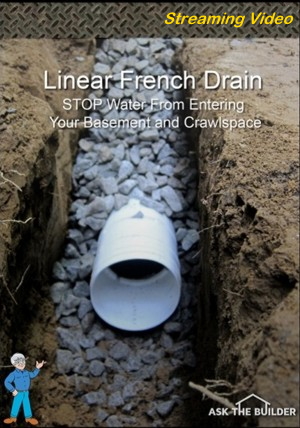Yard Drainage Solutions
DEAR TIM: I’m building a new home and am quite concerned about possible flooding that could happen. I built on a hill and the land slopes towards my home. The builder didn’t put in much of a ditch at all and it seems like bad things could happen with a very bad storm or extended period of heavy rain. Please look at the photo and tell me what you think. How do you correct a problem like this? What would you do if you were me? Theresa P., White River Junction, VT
DEAR THERESA: Congratulations on your new home! I remember the excitement my customers would exude as I transformed their dreams into reality. But I don’t want any water to ruin your new home and your possessions, so we need to solve the problem I see in the photo you sent. What I see is nearly identical to what’s happening at a new home construction site in my own neighborhood!
My college degree was in geology and I had a particular interest in hydrogeology and geomorphology. Hydrogeology is the study of ground water and geomorphology is the study of surface features of our Earth. The knowledge I gained allowed me to build bone-dry homes for myself and every customer.
Storm water is going to rush down the hill on the right and overwhelm this home!. Photo Credit: Tim Carter

Storm water is going to rush down the hill on the right and overwhelm this home!. Photo Credit: Tim Carter
If you watch the local and national news shows, you’ll see from time to time video of water pouring down hillsides at homes. What you’re worried about is very real and the quantity of water depends on how much land is above you and if that water is aimed at your home because of the natural funnel shape of the land near your home.
The first thing you might reference is the building code. However, realize that it’s a set of minimum standards. What that means is that if your home meets the building code it’s like getting seventy percent on a test. In other words, you passed by the skin of your teeth. In almost all cases it’s easy and not too much work to exceed code standards.
The last time I checked the building code said the ground surrounding a home must have 6 inches of vertical fall in the first 10 feet of horizontal distance away from the foundation. I can tell you that I see many homes that do not meet this and based on your photo I know for a fact yours doesn’t.
For an extreme example of how to handle water around your home, just look at the ditches you often see along country roads. The ditch might be 24 or 30 inches deep, often more. The drop off from the road shoulder can be steep. I’m not recommending you do this in your yard, but there’s surely a compromise.
What I always tried to do on the houses I built was to have the soil around the house come no closer than one foot from the top of the foundation. Then I’d slope the ground at least 1 foot down from the house in the first 10 feet of horizontal distance.
That might sound extreme to you, but believe it or not it’s a fairly gradual slope. Since you’ve not yet landscaped, now’s the time to get a small bulldozer in or an excavator to remove the soil to create the small swale in your yard.
This swale needs to have a slope in it so any water on the surface continue on around the house and flow to the lowest part of your lot where it would have flowed naturally before your home was built. Remember, it’s often illegal to divert water onto adjacent land that didn’t receive that amount of natural runoff before you built your home.
Often on my jobs, I’d install a hidden linear french drain in the bottom of the swale to capture underground water flowing through the soil. This water you can’t see can cause chronic seepage into basements and crawlspaces.
Once the yard is graded and you have this gentle channel that captures and redirects the water around your home, you put a narrow slit trench in the bottom of the swale. This trench only needs to be about 6 inches wide and usually 2 feet deep. The trench continues around the house and once the ground starts to slope away, the bottom of the trench gets shallower and shallower until it eventually breaks through to the surface.
I’d put a perforated drain pipe in this trench and fill the trench with washed gravel about the size of walnuts or pecans. You don’t want any sand in this gravel. The larger gravel allows water to flow rapidly down and into the perforated pipe. Once in the pipe, the water quickly goes around your home and exits in your yard where it won’t cause any harm to you or your possessions.
Remember to pipe all your roof water using solid 4-inch pipe to the lowest spot on your land. Don’t allow your builder to install useless splash blocks that just stop the dirt from eroding at the bottom of the downspout. If you allow all that roof water to just discharge around your home into your grass, you’ll add to the possibility of severe flooding in periods of heavy rain.

Splash blocks don't do much to channel water away from the foundation. © 2017 Roger Henthorn
This column answers Linda's question with her flooded basement. This was in the December 29, 2015 Newsletter.
Column 1122

3 Responses to Yard Drainage Solutions